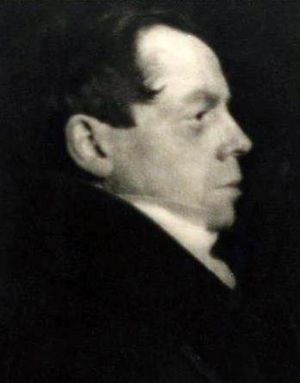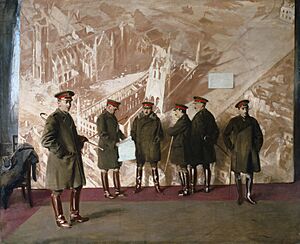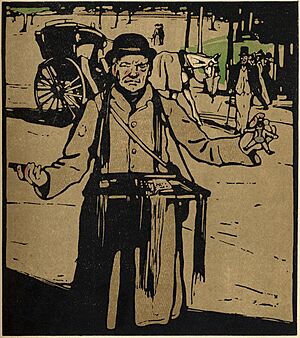William Nicholson (artist) facts for kids
Quick facts for kids
Sir William Nicholson
|
|
|---|---|

William Nicholson, photographed in Bloomsbury on 3 February 1908 by Alvin Langdon Coburn
|
|
| Born |
William Newzam Prior Nicholson
5 February 1872 Newark-on-Trent, Nottinghamshire, England
|
| Died | 16 May 1949 (aged 77) |
| Nationality | British |
| Known for | Painter of portraits, still-lifes and landscapes; engraver, graphic artist, illustrator |
| Spouse(s) | |
Sir William Newzam Prior Nicholson (born February 5, 1872 – died May 16, 1949) was a talented British artist. He was known for painting still-lifes (pictures of objects), landscapes (outdoor scenes), and portraits (pictures of people).
Besides painting, William Nicholson was also a skilled printmaker. He created art using techniques like woodcut and lithography. He was also an illustrator for books, including some for children, and designed sets for the theatre.
Contents
William Nicholson's Early Life and Family
William Nicholson was born in Newark-on-Trent, England, on February 5, 1872. His father, William Newzam Nicholson, was an industrialist and a Member of Parliament.
From the age of nine, William went to Magnus Grammar School. He took art lessons from William Cubley, a painter who had been taught by a student of Sir Joshua Reynolds, a famous artist. William also briefly studied at Hubert von Herkomer's art school. There, he met Mabel Pryde, who would become his wife. Mabel introduced him to her brother, James Pryde, who was also an artist.
In 1891, William went to study art in Paris at the Académie Julian. However, he returned home after only six months.
Marriage and Children
In 1893, William Nicholson and Mabel Pryde got married. They moved to a place called the Eight Bells in Denham, Bucks. Mabel's brother James soon joined them.
William and Mabel had four children. Their son Ben became a very famous painter. Another son, Anthony, sadly died during the First World War. Their daughter Nancy became an artist and married the poet Robert Graves. Their youngest son, Christopher, became an architect.
After Mabel passed away in 1918, William married Edith Stuart-Wortley in 1919. Edith was also a painter. They had a daughter named Liza.
From 1935 until his death, William Nicholson's close companion was the novelist Marguerite Steen. He passed away on May 16, 1949, in Blewbury, England.
William Nicholson's Artistic Creations
Graphic Design Work
From 1893 to 1898, William Nicholson worked with his brother-in-law, James Pryde. They teamed up on designing posters and other graphic art. They called themselves the Beggarstaffs. Their work was very creative and unique for its time.
Illustrating and Writing Books
William Nicholson created illustrations and cover designs for several books. Some of his early works include An Alphabet by William Nicholson and An Almanac of Twelve Sports with words by Rudyard Kipling.
He also illustrated famous children's books, such as The Velveteen Rabbit by Margery Williams (1922). William Nicholson also wrote and illustrated two of his own books for children: Clever Bill (1926) and The Pirate Twins (1929).
His Paintings

Around 1900, William Nicholson began to focus more on painting. He was encouraged by another famous artist, James Abbott McNeill Whistler. Nicholson's paintings were first shown at the International Society, where Whistler was the president.
Other Creative Projects
William Nicholson also worked in other creative fields. In 1904, he designed the original stage sets for the famous play Peter Pan. He also designed for other plays and created stained glass art.
Teaching Art
William Nicholson also taught art to others. One of his most famous students in the 1930s was Winston Churchill, who later became the Prime Minister of the United Kingdom. Churchill once wrote that he felt William Nicholson taught him the most about painting.
Published Works by William Nicholson
As Author and Illustrator
- An Alphabet. London: William Heinemann, 1898.
- Clever Bill. [London]: William Heinemann, [1926].
- The Pirate Twins. [London]: Faber & Faber, [1929].
As Illustrator Only
- An Almanac of Twelve Sports. Verses by Rudyard Kipling, illustrations by William Nicholson. London: William Heinemann, 1897.
- The Velveteen Rabbit, or, How Toys Became Real. Margery Williams, illustrations by William Nicholson. London: William Heinemann, 1922.
Exhibitions of William Nicholson's Art
William Nicholson's art was shown in many exhibitions during his lifetime and after. Here are some of the most important ones:
- 1903: Stafford Gallery, London – This was his first solo show.
- 1911: Goupil Galleries, London – Showed his oil paintings.
- 1933: Castle Museum and Art Gallery, Nottingham – This was his first "retrospective" exhibition, which means it looked back at his work over many years.
- 1942: National Gallery, London – Another important retrospective exhibition.
- 2004–2005: Royal Academy of Arts, London – A major exhibition showcasing his work as a painter and printmaker.
See also
 In Spanish: William Nicholson para niños
In Spanish: William Nicholson para niños



